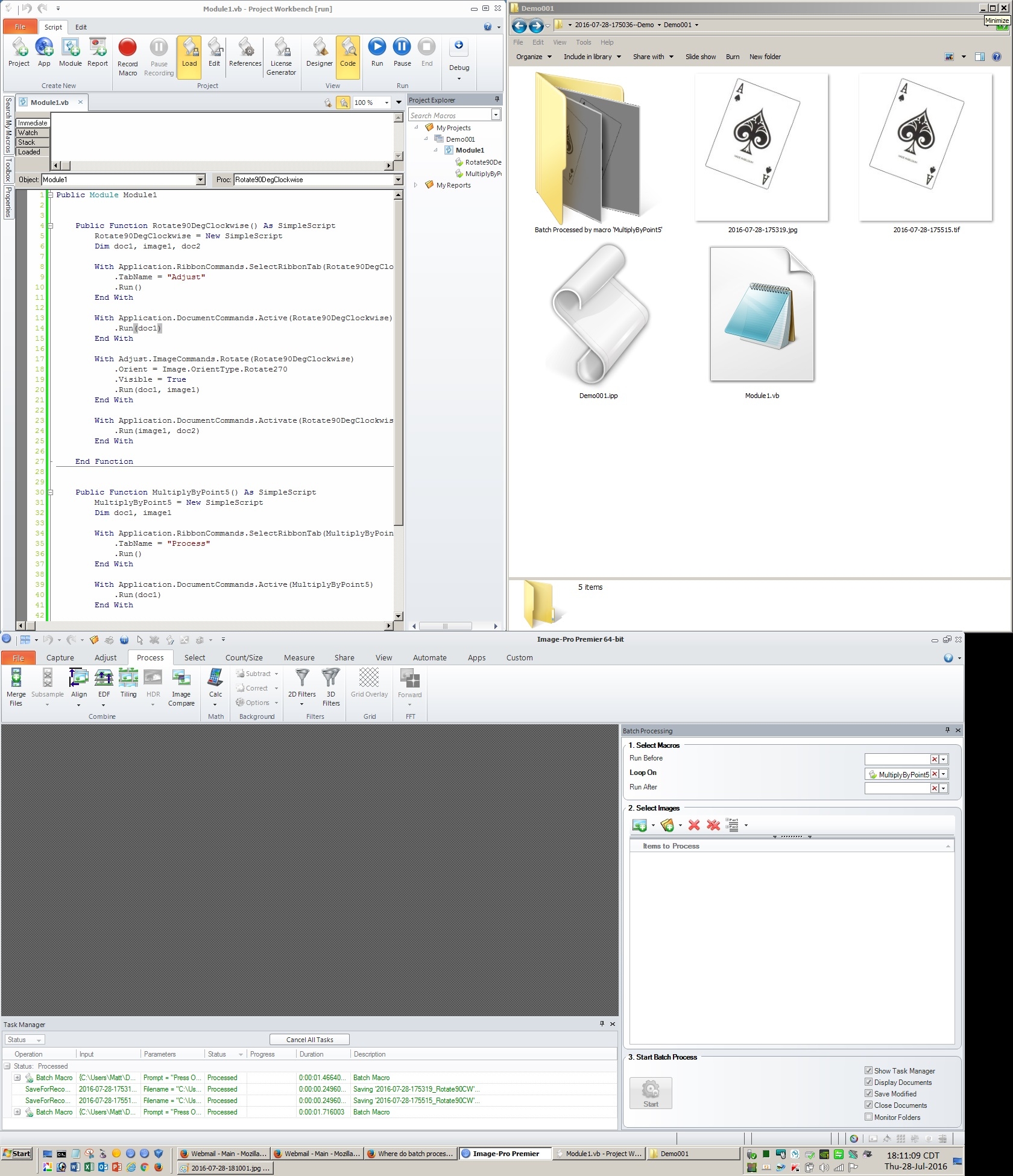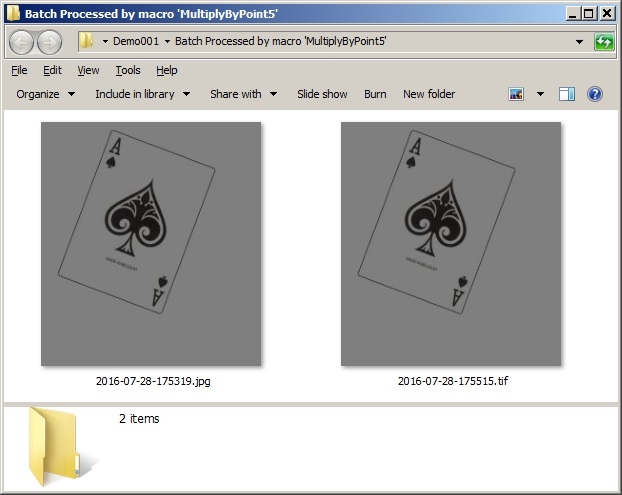Where do batch processing files get saved
I am doing batch processing and have checked the "save modified" box, but the processed images do not appear to be saved. The images get processed appropriately (they are present if I check "display documents" but I cannot find save versions anywhere. There is no indication in the task manager that they are being saved.
Thanks
Ross Taliano
Thanks
Ross Taliano
0
Answers
-
Rtaliano --
There is much I have yet to learn about PREMIER so I poked at your question a bit to see if there was an easy answer.
I created two ROUTINES to use with the BATCH PROCESSING FUNCTION.
The first (Rotate90DegClockwise) does not modify the ORIGINAL IMAGE but creates a NEW IMAGE.
The second (MultiplyByPoint5) does modify the ORIGINAL IMAGE.
The first image below is BEFORE running the ROTATE ROUTINE on the IMAGES in the DEMO001 FOLDER.
The second image below is After running the ROTATE ROUTINE on the IMAGES in the DEMO001 FOLDER.
Please note that the NEW IMAGES generated by the ROTATE ROUTINE were not SAVED or CLOSED by the BATCH PROCESSING FUNCTION.
The third image below is BEFORE running the MULTIPLY ROUTINE on the IMAGES in the DEMO001 FOLDER.
The fourth image below is AFTER running the MULTIPLY ROUTINE on the IMAGES in the DEMO001 FOLDER.
Notice in the case of the MULTIPLY ROUTINE that the ORIGINAL IMAGE was MODIFIED by the ROUTINE and that BATCH PROCESSING FUNCTION saved the MODIFIED IMAGE in a NEW FOLDER (named "Batch Processed by macro 'MultiplyByPoint5'" in this case.)
Please see the fifth image below.
If the ROUTINE that you are working with is like the ROTATE ROUTINE and it creates a NEW IMAGE, then your ROUTINE is going going to have to perform a SAVE OPERATION.
You can get the FILE NAME for your ORIGINAL IMAGE using
ThisApplication.ActiveDocument.FileName
You can then use something likePublic Function mysave() As SimpleScript mysave = New SimpleScript Dim image1, doc1 With Application.DocumentCommands.ActiveImage(mysave) .Run(image1) End With With Application.DocumentCommands.SaveAs(mysave) .Filename = "C:\Users\Matt\Desktop\fred.jpg" .Run(image1) End With With Application.DocumentCommands.Activate(mysave) .Run(image1, doc1) End With End Functionwhere you change.Filename = "C:\Users\Matt\Desktop\fred.jpg"
in an appropriate way based on the name of the original image.
Please note that there seem to be some issues within PREMIER if the image that you are STARTING with is a JPG IMAGE and then you command PREMIER to save that image as a TIF.
If this is your case, please look at
http://forums.mediacy.com/discussion/664/calibration-not-being-saved-with-tif-image-in-premier-9-2#latest
I hope this information is helpful.
-- Matt
*-*-*-*-*-*-*-*-*-*-*-*-*-*-*-*-*-*-*-*-*-*-*-*-*-*-*-*-*-*-*-*-*-*-*-*-*-*-*-*-*-Public Function Rotate90DegClockwise() As SimpleScript Rotate90DegClockwise = New SimpleScript Dim doc1, image1, doc2 With Application.RibbonCommands.SelectRibbonTab(Rotate90DegClockwise) .TabName = "Adjust" .Run() End With With Application.DocumentCommands.Active(Rotate90DegClockwise) .Run(doc1) End With With Adjust.ImageCommands.Rotate(Rotate90DegClockwise) .Orient = Image.OrientType.Rotate270 .Visible = True .Run(doc1, image1) End With With Application.DocumentCommands.Activate(Rotate90DegClockwise) .Run(image1, doc2) End With End Function Public Function MultiplyByPoint5() As SimpleScript MultiplyByPoint5 = New SimpleScript Dim doc1, image1 With Application.RibbonCommands.SelectRibbonTab(MultiplyByPoint5) .TabName = "Process" .Run() End With With Application.DocumentCommands.Active(MultiplyByPoint5) .Run(doc1) End With With Process.ProcessCommands.Operations(MultiplyByPoint5) .Operation = eOperation.Mult .NumberValue = 0.5R .ResultType = eResultType.Apply .Run(doc1, Nothing, image1) End With End Function




0 -
Ross,
Matt is right to point out that the batch processing "save documents" only saves image files loaded and modified by the batch, not newly created images.- Images loaded and modified by the batch are saved in a folder called "Batch Processed by macro ..." which is a subfolder of the directory of which the image is coming from.
- New images resulting from some batch operations have to be saved explicitely using the Save command.
0
Categories
- All Categories
- 964 Image-Pro v9 and higher
- 9 Image-Pro FAQs
- 18 Image-Pro Download & Install
- 450 Image-Pro General Discussions
- 487 Image-Pro Automation (Macros, Apps, Reports)
- 20 AutoQuant Deconvolution
- 2 AutoQuant Download & Install
- 18 AutoQuant General Discussions
- 195 Image-Pro Plus v7 and lower
- 3 Image-Pro Plus Download & Install
- 106 Image-Pro Plus General Discussions
- 86 Image-Pro Plus Automation with Macros
- 19 Legacy Products
- 16 Image-Pro Premier 3D General Discussions
- 26 Image-Pro Insight General Discussions
